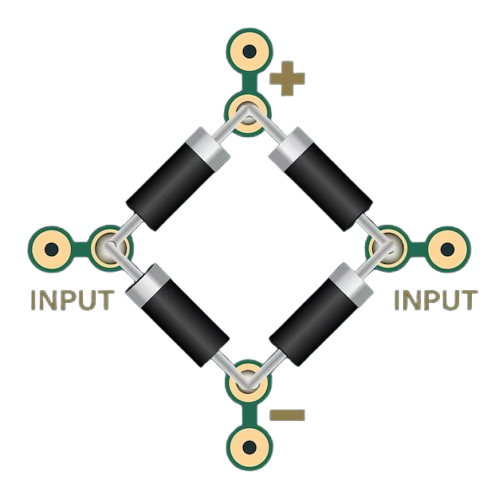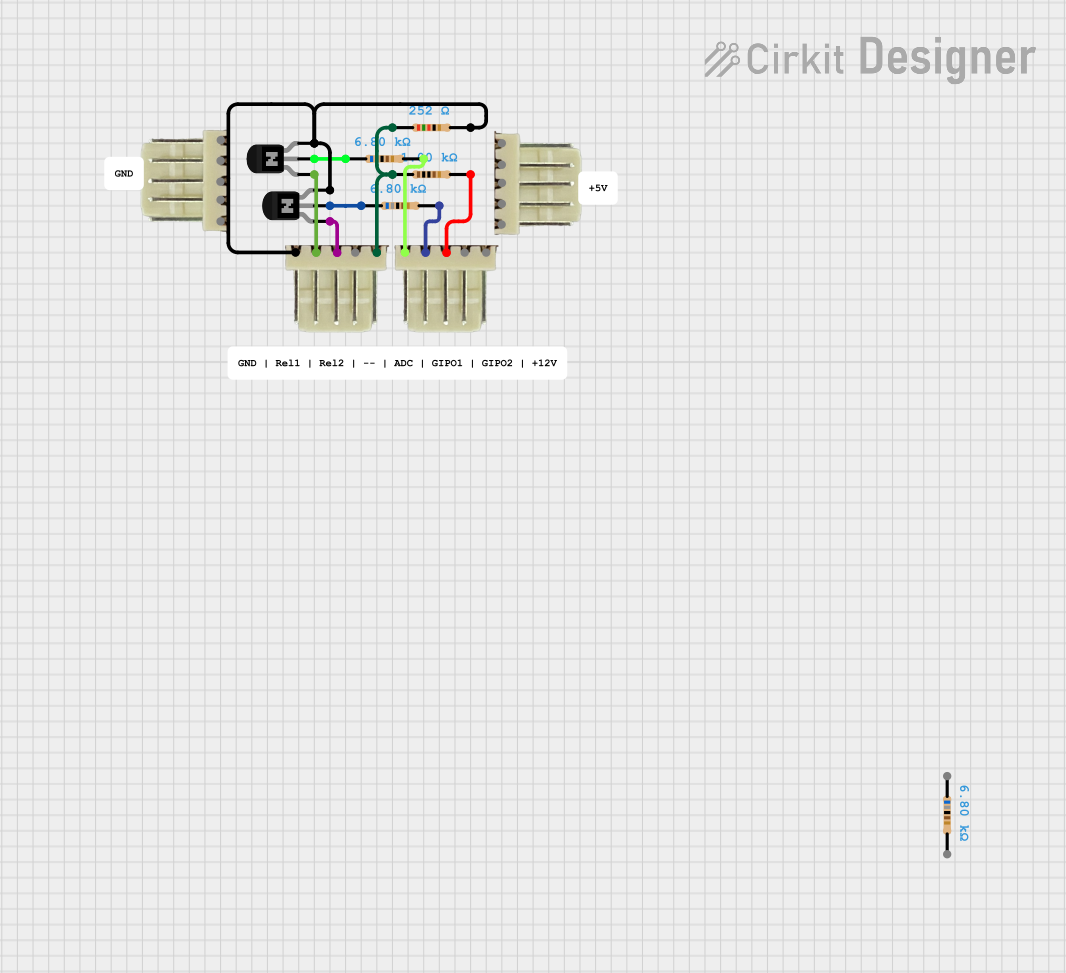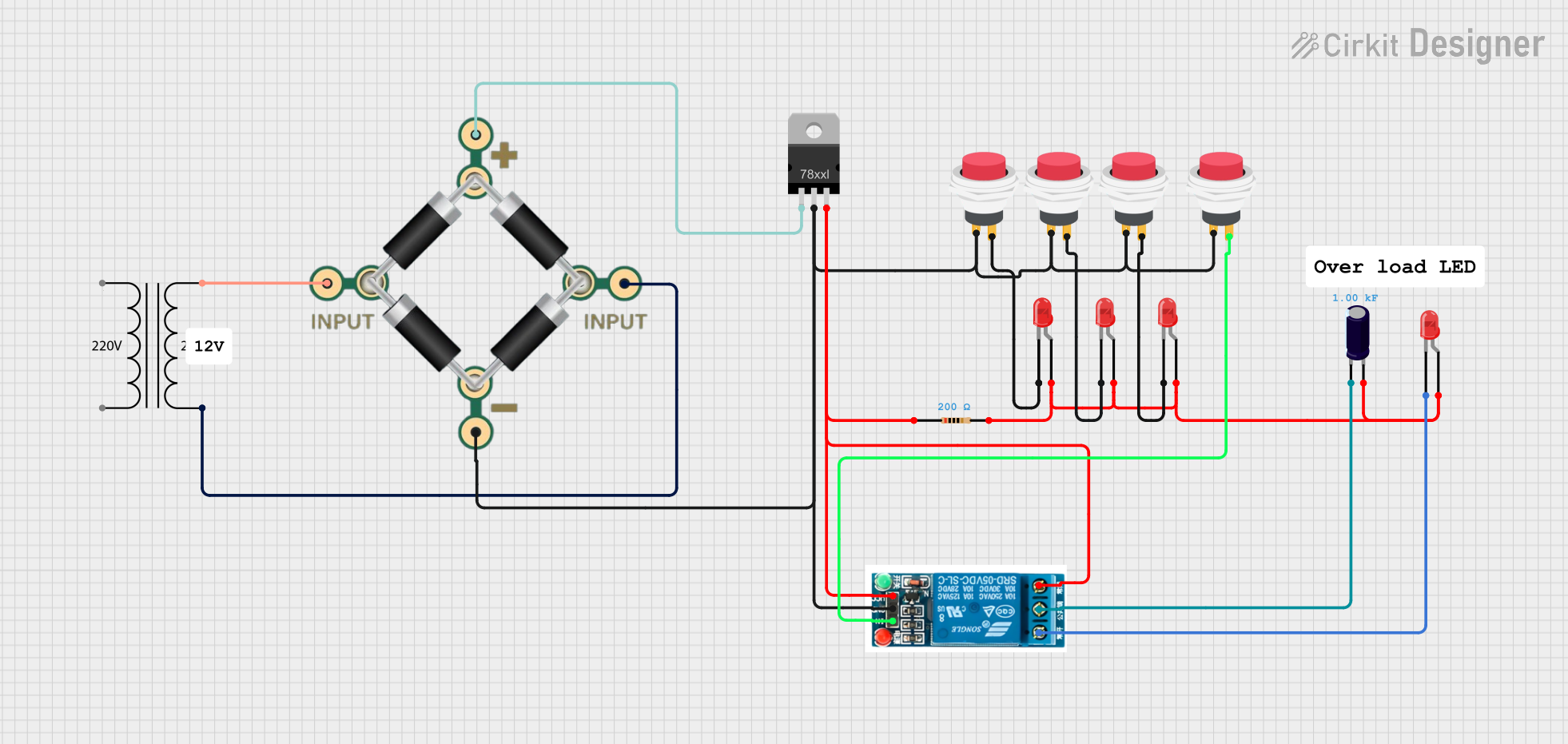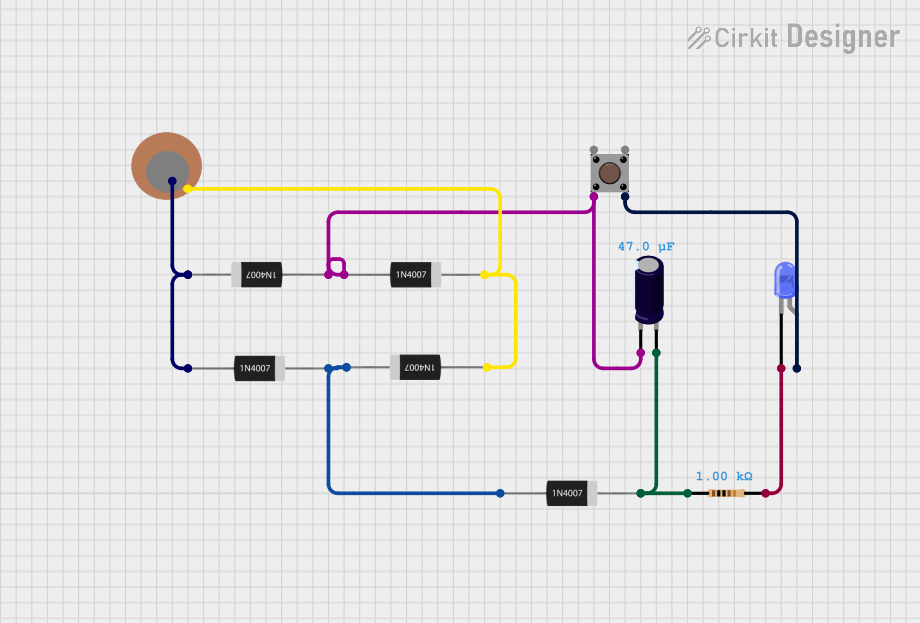
How to Use BRIDGE - 1N4007: Examples, Pinouts, and Specs

 Design with BRIDGE - 1N4007 in Cirkit Designer
Design with BRIDGE - 1N4007 in Cirkit DesignerIntroduction
The 1N4007 is a silicon rectifier diode designed for general-purpose applications. It is capable of withstanding a maximum reverse voltage of 1000V and can handle a forward current of up to 1A. This diode is widely used in power supply circuits for converting alternating current (AC) to direct current (DC). Its robust design and high voltage rating make it suitable for a variety of electronic projects, including rectification, voltage blocking, and polarity protection.
Explore Projects Built with BRIDGE - 1N4007

 Open Project in Cirkit Designer
Open Project in Cirkit Designer
 Open Project in Cirkit Designer
Open Project in Cirkit Designer
 Open Project in Cirkit Designer
Open Project in Cirkit Designer
 Open Project in Cirkit Designer
Open Project in Cirkit DesignerExplore Projects Built with BRIDGE - 1N4007

 Open Project in Cirkit Designer
Open Project in Cirkit Designer
 Open Project in Cirkit Designer
Open Project in Cirkit Designer
 Open Project in Cirkit Designer
Open Project in Cirkit Designer
 Open Project in Cirkit Designer
Open Project in Cirkit DesignerCommon Applications
- AC to DC rectification in power supplies
- Voltage blocking in circuits
- Polarity protection for sensitive components
- Freewheeling diode in inductive loads (e.g., motors, relays)
Technical Specifications
Below are the key technical details of the 1N4007 diode:
| Parameter | Value |
|---|---|
| Maximum Reverse Voltage | 1000V |
| Maximum Forward Current | 1A |
| Peak Surge Current | 30A (8.3ms single half-sine) |
| Forward Voltage Drop | 0.7V (typical at 1A) |
| Reverse Current | 5µA (at 25°C) |
| Operating Temperature | -55°C to +150°C |
| Package Type | DO-41 (Axial Lead) |
Pin Configuration
The 1N4007 diode has two terminals:
| Pin | Description |
|---|---|
| Anode | Positive terminal (current enters) |
| Cathode | Negative terminal (current exits) |
The cathode is marked with a silver or white band on the diode body.
Usage Instructions
How to Use the 1N4007 in a Circuit
- Rectification: Use the 1N4007 in a bridge rectifier configuration to convert AC to DC. Connect four diodes in a bridge arrangement to achieve full-wave rectification.
- Polarity Protection: Place the diode in series with the power supply to prevent damage to components from reverse polarity.
- Freewheeling Diode: Connect the diode across an inductive load (e.g., relay or motor) to suppress voltage spikes when the load is turned off.
Important Considerations
- Current Rating: Ensure the forward current does not exceed 1A. For higher currents, use multiple diodes in parallel or select a higher-rated diode.
- Heat Dissipation: If the diode operates near its maximum current rating, consider adding a heatsink or ensuring proper ventilation to prevent overheating.
- Reverse Voltage: Do not exceed the maximum reverse voltage of 1000V to avoid breakdown.
Example: Using the 1N4007 with an Arduino UNO
The 1N4007 can be used to protect an Arduino UNO from reverse polarity. Below is an example circuit and code:
Circuit
- Connect the anode of the 1N4007 to the positive terminal of the power supply.
- Connect the cathode (marked with a silver band) to the VIN pin of the Arduino UNO.
- Connect the negative terminal of the power supply to the GND pin of the Arduino.
Code Example
// Simple Arduino code to blink an LED
// This assumes the 1N4007 is used for polarity protection on the VIN pin.
const int ledPin = 13; // Built-in LED pin on Arduino UNO
void setup() {
pinMode(ledPin, OUTPUT); // Set LED pin as output
}
void loop() {
digitalWrite(ledPin, HIGH); // Turn LED on
delay(1000); // Wait for 1 second
digitalWrite(ledPin, LOW); // Turn LED off
delay(1000); // Wait for 1 second
}
Troubleshooting and FAQs
Common Issues
Diode Overheating:
- Cause: Exceeding the maximum forward current of 1A.
- Solution: Reduce the load current or use a higher-rated diode.
No Output in Rectifier Circuit:
- Cause: Incorrect diode orientation.
- Solution: Verify the anode and cathode connections. The cathode should face the negative side of the load.
High Reverse Leakage Current:
- Cause: Operating the diode at high temperatures.
- Solution: Ensure proper cooling and avoid exceeding the maximum operating temperature.
Diode Breakdown:
- Cause: Exceeding the maximum reverse voltage of 1000V.
- Solution: Use a diode with a higher reverse voltage rating if needed.
FAQs
Q1: Can I use the 1N4007 for high-frequency applications?
A1: No, the 1N4007 is not suitable for high-frequency applications due to its slow recovery time. Use a fast recovery or Schottky diode for such purposes.
Q2: Can I use the 1N4007 in parallel to increase current capacity?
A2: Yes, but ensure proper current sharing by adding small resistors in series with each diode to balance the load.
Q3: How do I identify the cathode of the 1N4007?
A3: The cathode is marked with a silver or white band on the diode body.
Q4: What is the difference between the 1N4007 and other diodes in the 1N400x series?
A4: The primary difference is the maximum reverse voltage rating. The 1N4007 has the highest rating (1000V) in the series.